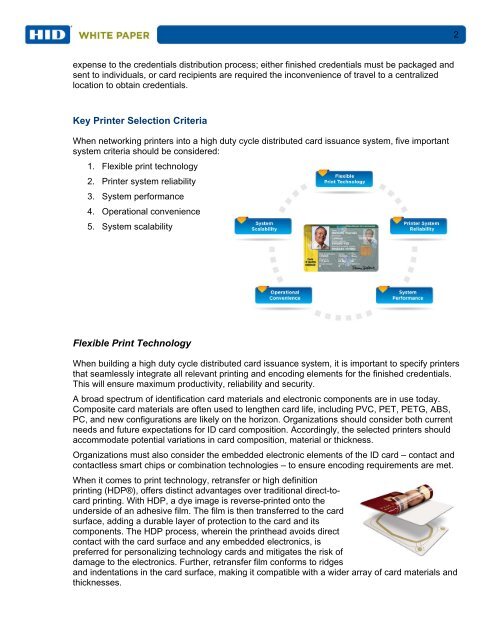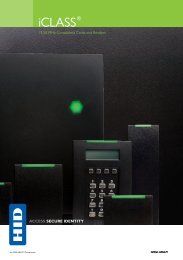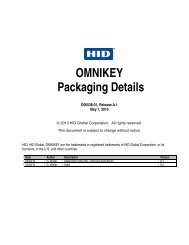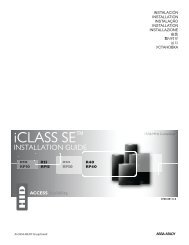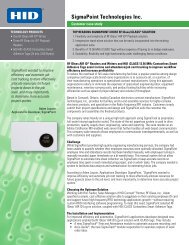FARGO HDP8500 Whitepaper - HID Global
FARGO HDP8500 Whitepaper - HID Global
FARGO HDP8500 Whitepaper - HID Global
You also want an ePaper? Increase the reach of your titles
YUMPU automatically turns print PDFs into web optimized ePapers that Google loves.
expense to the credentials distribution process; either finished credentials must be packaged and<br />
sent to individuals, or card recipients are required the inconvenience of travel to a centralized<br />
location to obtain credentials.<br />
Key Printer Selection Criteria<br />
When networking printers into a high duty cycle distributed card issuance system, five important<br />
system criteria should be considered:<br />
1. Flexible print technology<br />
2. Printer system reliability<br />
3. System performance<br />
4. Operational convenience<br />
5. System scalability<br />
Flexible Print Technology<br />
When building a high duty cycle distributed card issuance system, it is important to specify printers<br />
that seamlessly integrate all relevant printing and encoding elements for the finished credentials.<br />
This will ensure maximum productivity, reliability and security.<br />
A broad spectrum of identification card materials and electronic components are in use today.<br />
Composite card materials are often used to lengthen card life, including PVC, PET, PETG, ABS,<br />
PC, and new configurations are likely on the horizon. Organizations should consider both current<br />
needs and future expectations for ID card composition. Accordingly, the selected printers should<br />
accommodate potential variations in card composition, material or thickness.<br />
Organizations must also consider the embedded electronic elements of the ID card – contact and<br />
contactless smart chips or combination technologies – to ensure encoding requirements are met.<br />
When it comes to print technology, retransfer or high definition<br />
printing (HDP®), offers distinct advantages over traditional direct-tocard<br />
printing. With HDP, a dye image is reverse-printed onto the<br />
underside of an adhesive film. The film is then transferred to the card<br />
surface, adding a durable layer of protection to the card and its<br />
components. The HDP process, wherein the printhead avoids direct<br />
contact with the card surface and any embedded electronics, is<br />
preferred for personalizing technology cards and mitigates the risk of<br />
damage to the electronics. Further, retransfer film conforms to ridges<br />
and indentations in the card surface, making it compatible with a wider array of card materials and<br />
thicknesses.<br />
2


